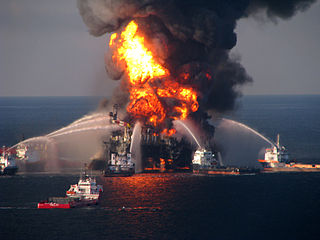
A nuclear and radiation accident is defined by the International Atomic Energy Agency (IAEA) as "an event that has led to significant consequences to people, the environment or the facility. Examples include lethal effects to individuals, large radioactivity release to the environment, reactor core melt." The prime example of a "major nuclear accident" is one in which a reactor core is damaged and significant amounts of radioactive isotopes are released, such as in the Chernobyl disaster in 1986 and Fukushima nuclear disaster in 2011.

The Donbas or Donbass is a historical, cultural, and economic region in eastern Ukraine. Parts of the Donbas are occupied by Russia as a result of the Russo-Ukrainian War.
A mining accident is an accident that occurs during the process of mining minerals or metals. Thousands of miners die from mining accidents each year, especially from underground coal mining, although accidents also occur in hard rock mining. Coal mining is considered much more hazardous than hard rock mining due to flat-lying rock strata, generally incompetent rock, the presence of methane gas, and coal dust. Most of the deaths these days occur in developing countries, and rural parts of developed countries where safety measures are not practiced as fully. A mining disaster is an incident where there are five or more fatalities.

Yenakiieve is a city and the nominal administrative center of Yenakiieve urban hromada in the Horlivka Raion, Donetsk Oblast of Ukraine. The city stands on the Krynka River about 60 kilometres (37 mi) from the oblast's administrative center, Donetsk. Its population is approximately 76,673 .
Nuclear Explosions for the National Economy was a Soviet program to investigate peaceful nuclear explosions (PNEs). It was analogous to the United States program Operation Plowshare.

Nuclear power has various environmental impacts, both positive and negative, including the construction and operation of the plant, the nuclear fuel cycle, and the effects of nuclear accidents. Nuclear power plants do not burn fossil fuels and so do not directly emit carbon dioxide. The carbon dioxide emitted during mining, enrichment, fabrication and transport of fuel is small when compared with the carbon dioxide emitted by fossil fuels of similar energy yield, however, these plants still produce other environmentally damaging wastes. Nuclear energy and renewable energy have reduced environmental costs by decreasing CO2 emissions resulting from energy consumption.

The 2007 Zasyadko mine disaster was a mining accident that happened on November 18, 2007 at the Zasyadko coal mine in the eastern Ukrainian city of Donetsk.

Zasyadko Mine is a coal mining company in Ukraine's eastern city of Donetsk. Following the start of the War in Donbass in 2014 the mine became situated in rebel controlled territory.

The health and environmental impact of the coal industry includes issues such as land use, waste management, water and air pollution, caused by the coal mining, processing and the use of its products. In addition to atmospheric pollution, coal burning produces hundreds of millions of tons of solid waste products annually, including fly ash, bottom ash, and flue-gas desulfurization sludge, that contain mercury, uranium, thorium, arsenic, and other heavy metals. Coal is the largest contributor to the human-made increase of carbon dioxide in Earth's atmosphere.

Coal mining has historically been an important industry in Ukraine. Coal mining in Ukraine is often associated with coal-rich Donets basin. However this is not the only coal mining region, other being Lviv-Volhynian basin and Dnieper brown coal mining basin. The Donets basin located in the eastern Ukraine is the most developed and much bigger coal mining region in the country.

Energy resources bring with them great social and economic promise, providing financial growth for communities and energy services for local economies. However, the infrastructure which delivers energy services can break down in an energy accident, sometimes causing considerable damage. Energy fatalities can occur, and with many systems deaths will happen often, even when the systems are working as intended.

The Donetsk People's Republic is an internationally unrecognised republic of Russia in the occupied region of eastern Ukraine's Donetsk Oblast, with its capital in Donetsk. The DPR was created by Russian-backed paramilitaries in 2014, and it initially operated as a breakaway state until it was annexed by Russia in 2022.

During the ongoing Russo-Ukrainian War between the Ukrainian government forces and pro-Russian separatists in the Donbas region of Ukraine that began in April 2014, many international organisations and states noted a deteriorating humanitarian situation in the conflict zone.
Yunokomunarivsk, officially Bunhe is a city in Yenakiieve urban hromada, Horlivka Raion, Donetsk Oblast (province) of Ukraine. Population: 13,495 , 14,154 (2013 est.), 17,813 (2001).
The 2022 Russian invasion of Ukraine has led to widespread and possibly serious and long-term environmental damage with the Ukrainian government, international observers and journalists describing the damage as ecocide.
The general mobilization in the Donetsk People's Republic and the Luhansk People's Republic began on 19 February 2022, 5 days before the start of Russia's full-scale invasion of Ukraine. Tens of thousands of local residents were forcibly mobilized for the war.












